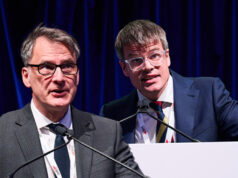In the picturesque town of L’Aquila, surrounded by breathtaking mountains, the 4th National Congress of the Italian Society of Vascular and Endovascular Surgery (SICVE) took place between the 28th September and 1st of October. Vascular News could not miss the chance to attend this meeting that is one of the more proactive scientific societies in Europe.
The meeting was hosted by Professor Carlo Spartera, L’Aquila University, who stated, “This year we decided to concentrate all sessions in the main auditorium to gather the largest audience for each session. It has been an opportunity for meeting national and international specialists, gathering important information to improve the performance of every specialized centre, which can lead to improving a better quality of life for the patients. In the initiatives that will take place this year we would like to mention two symposiums: the first in collaboration with the Society of Italians Young Surgeons and the second in conjunction with Italian Stroke Forum, an Italian association very active in promoting several initiatives and activities in the fields of prevention, cure and rehabilitation. In order to decrease social/medical consequences of cerebral Ictus.” Ictus is the first cause of permanent invalidity in Italy and the second cause of death. Nearly the 6.5% of Italian population over 65 is affected every year from Ictus.
At the meeting, the Society promoted a training programme on carotid stenting that includes theory section and a virtual reality practice, which incorporated training in a centre recognised by the Society and a tutorial session in its own centre. The programme is open to vascular surgeons who wish to improve their endovascular skills. The Society is also considering repeating this kind of initiative on laparascopic procedures as well.
The main theme of the meeting was course guidelines, ensuring that the technical and ethical guidelines of practice are at the top its agenda. Specifically the course is centred on three areas: Carotid interventions, thoracic aorta (in this specific area SICVE is one of the first scientific society in the world to be endowed with guidelines) and tibial angioplasty.
Vascular News asked Professor Domenico Palombo, S Martino Hospital, Genoa, and the current President of SICVE, to comment on this year’s meeting and on future initiatives, “Guidelines are an important tool to monitor the rapid evolution of the profession. We established a special commission in order to write the guidelines, both technical and ethical. This is in agreement with the two main concepts at the core of our society: Professionalism and Ethics. It is important for the growth of our specialty to gain a better understanding of vascular surgery and the scientific society. SICVE is considering promoting initiatives to exchange information to encourage awareness of the importance of disease prevention.”
Palombo also commented on which treatment should be considered: “Both options (surgical and endovascular) are valid and they can be used by specialists to solve different and more complex arterial pathologies. The vascular surgeon is the only specialist that, because of his deep knowledge of different pathologies and treatments, can propose the right cure of vascular diseases. Only through studying carefully the single case it is possible to choose the right treatment, that is not necessarily endovascular, except in those circumstances where this methodical can be decisive.”
In addition, SICVE has his own registry that includes submissions from a total of 72 centres through a computerized database, where is possible through an input tool to insert data directly on the website and compare personal data with the national trends. SICVE is also launching a system of ethical checks on the data submitted. Some centres are selected randomly and asked to send hospital documents to prove the reliability of the data. Palombo said, “The reliability of national registries, in terms of quality, is a common issue everywhere in Europe. We are providing transparency in our data as well as scientific importance.”
During the meeting an entire session was been dedicated to phlebology, where discussion on new techniques, such as radio frequency, laser and echosclerosis. Finally, the meeting also included an important session on limb salvage, on the opportunity of intervening on artery occlusion in this part of the body and also on the new aspects regarding the cerebral-vascular insufficiency.
At the end of the meeting, Spartera commented, “The fact that more than 800 vascular and endovascular clinicians have taken part compare and discuss the topics makes us very pleased. In the last four days we have managed to discuss several issues and cover the full range of diseases areas through more than 60 lectures.”













